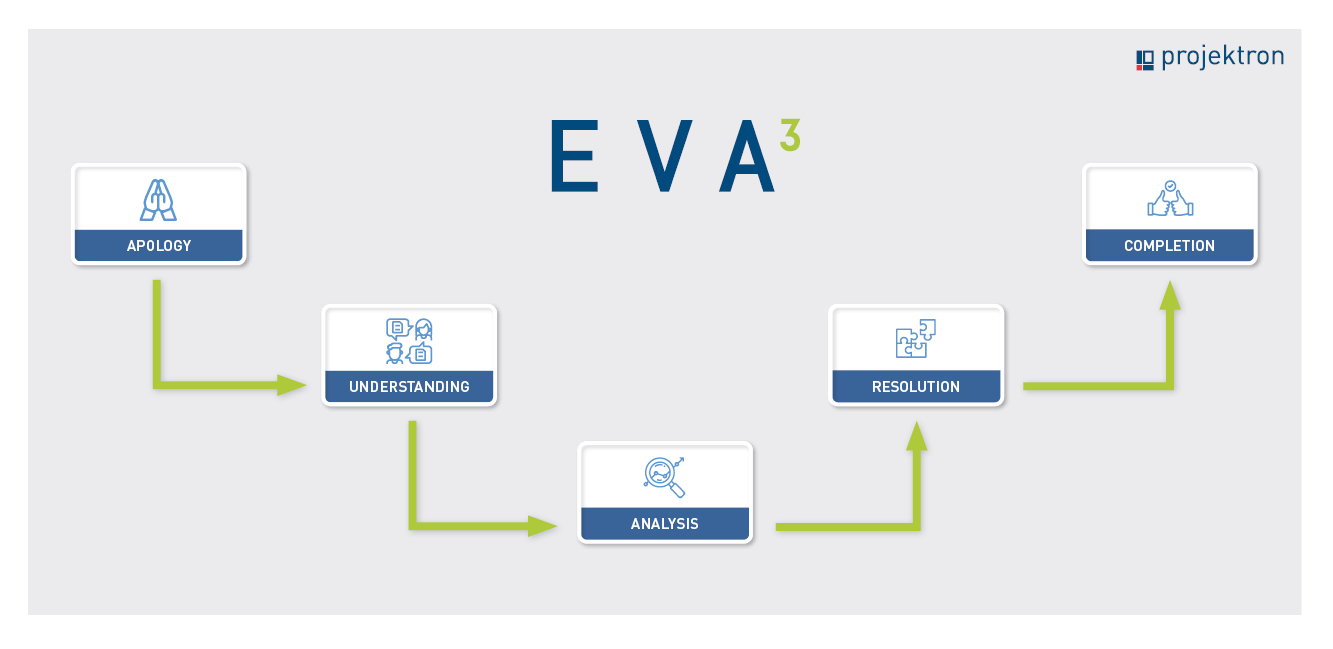09/01/2021 - Articles
EVA3 in complaint management: customer-oriented conflict resolution in 5 steps
Can you handle criticism? EVA3 helps you to establish a scheme for your handling of customer complaints. What the EVA3 method is, how you can successfully establish it for conflict resolution in your company's complaint management and how you can benefit from using it, you will learn in this article.
What is the EVA3 method?
You can't make an omelet without breaking eggs. Or to put it another way: Wherever people cooperate in business - whether as colleagues within a team or in the form of a company-customer relationship - differences of opinion and conflicts are inevitable. Dealing with this and leading customer complaints to a conciliatory solution is the task of complaint management.
In complaint management, it is important to proceed in a structured and planned manner, particularly with regard to complaint acceptance, complaint processing, and also complaint evaluation. The goals of both parties, i.e., the customer as the complainant and the company as the recipient of the complaint, are clear:
- The customer wants to be taken seriously in his concerns.
- You do not want to lose the customer, but to retain him in the long term.
- You both want to solve the problem.
One method you can use not only to solve the customer's problem, but also to increase customer satisfaction, improve customer loyalty, and at the same time strengthen your understanding of your customers' needs is EVA3. Of course, there is no "one-answer-fits-all," no blueprint for complaint management, no guarantee of happy customers. But the EVA3 method does provide a basic framework or action guide to help you structure your complaint management and standardize it to a certain degree.
The EVA3 principle unfolds its full strength in the case of justified and verbally presented customer complaints that are received by telephone in a customer support center, for example.

Complaint Management in 5 Steps - What EVA3 Stands for
EVA3 could also be referred to as EV3xA or EVAAA. Behind the acronym are 5 steps that describe the process from accepting a complaint to closing the complaint process with a positive resolution for both parties.
EVA3 stands for:
- apologize (in German "entschuldigen - E)
- understand (in German "verstehen" - V)
- analyze (in German "analysieren" - A)
- resolve (in German "auflösen" - A)
- conclude (in German "abschließen" - A)
The five steps are described in more detail below.

Step 1: "E" - Ask for apology
A pronounced "Please accept my apologies" is not meant as mere lip service, nor is it meant as anticipatory obedience or a blind admission of guilt. Rather, it should be a serious and sincere request for an apology. However, this presupposes that you actually take the reason for the complaint seriously from the customer's point of view and learn to understand the motivation for his complaint.
In order to be able to understand a complaint at all, however, it is absolutely necessary to listen and empathize with the customer's perspective. The apology must therefore always be preceded by the complainant being able to state his or her concerns in full. So the "E" should actually be preceded by a "Z" like "listening," but admittedly - "ZEVA3" just doesn't sound as good.
With an apology, you admit mistakes. If you are convinced you did not make a mistake but understand the customer's concern, you should not apologize but express regret for the customer's problem as well.

Step 2: "V" - show understanding
In order to show understanding, active listening is an absolute prerequisite. But active listening also means responding to the customer's complaint, asking questions, and signaling that the customer's message is being received. To do this, it makes sense to pick up on the customer's formulations directly and integrate them into questions and answers.
As the recipient of the complaint, you should never refer the customer's criticism to yourself. Show understanding not only for the actual problem that the customer describes, but also for his emotional situation, which is usually characterized by frustration in the case of a complaint. As a rule, the anger is not directed at you as a person. Therefore, always remain factual and objective.

Step 3: "A" - Analysis of the problem
Particularly if the customer is in a highly emotional state, it is important that you start looking for the actual problem and thus the trigger of his frustration. The only thing that helps here is calm questioning. After each question, however, give the customer enough time to talk things out. In complaint handling, only the customer's point of view counts, not your own or that of your employees.
Give your customer the feeling that he is valued and that his concerns are taken seriously. Help him verbalize and accurately describe the problem. The more the customer reports, the more likely it is that he will name the actual core of his problem in his agitation and outline it more concretely.
Often, the current complaint is only the cause of a deeper problem. This is often not revealed during the analysis if steps one and two are skipped.

Step 4: "A" - Resolution of the problem
As soon as you succeeded in identifying the problem, you should name it concretely. This point represents a turning point in the course of the conversation: From now on, it is no longer about the causes of the problem, but only about the solution. There are essentially two scenarios here:
If the problem can be easily solved, for example, if the customer has made an operating error, you should not make any accusations or blame. On the contrary, express understanding for the fact that your customer did not find the solution himself.
If the problem cannot be solved directly, you should try to actively involve the customer in finding a solution. For example, in the case of a complaint about a supposedly missing function in a piece of software, ask the customer specific questions:
- What feature or function would you like to see?
- How would the navigation guidance have to be improved so that you can easily find the desired function?
- In such a case, would you like to see more help in the product itself?
- What would we have to improve so that the usability of the function in question meets your expectations?

Step 5: "A" - closure of the complaint case
Bring the conversation to a conciliatory conclusion. The goal is to dismiss the customer
- in a positive basic mood,
- with a good impression of the customer service representative and the entire company, and
- the feeling of having solved the problem.
Therefore, thank your customer for voicing their complaint. If you were really able to help the customer and successfully solve his problem, express your pleasure. If the problem cannot be solved directly, explain in a comprehensible and transparent manner exactly why this is the case.
Tip: If you have to forward complaints internally and forward them to other agents or supervisors for review, make every effort to process and evaluate them quickly. Communicate clearly to the customer when they can expect a response.
Use Case Complaint Email: EVA3 adapted
The EVA3 concept was developed primarily for verbal conversations in which customers present justified complaints. Therefore, the method is particularly suitable for handling justified customer complaints in the B2C context. However, the EVA3 basic principle can also be transferred to the processing of written customer complaints in the B2B context. Even if the customer complaint is unjustified, EVA3 is perfectly applicable as a scheme.
Be careful when doing so! For example, if you are arguing with a customer about billed expenses, an apology can easily be interpreted as an admission of guilt on your part. In this case, "E" becomes "B": "Express regret". An appropriate response to a complaint email might look something like this:
Dear Mr. XY,
I regret that we did not meet your expectations (regret, no apology!). Of course, I can understand your point of view very well and comprehend your argumentation (understanding).
The case you describe is indeed, as you have already correctly pointed out, a very specific regulation from a collective agreement. We are currently not aware of any other customer who has this requirement (analysis). Therefore, unfortunately, we cannot implement your request only at Projektron's expense (resolution).
The issue is unfortunately not standard worthy and requires an adjustment ticket. Therefore, and based on your comment of 02/24/20xx, we are including this ticket as a suggestion (closure).
Thank you very much for your suggestion. We look forward to continued good cooperation.
Accept complaints with EVA3 - deepen customer relationships
The complaint offers you the opportunity to enter into direct dialog with your customer and to find out unfiltered what he wants and expects from you and your products. No customer questionnaire or other primary market research instrument will provide you with more honest answers and qualitatively better insights than a complaint.
Complaint management is therefore an elementary part of Customer Relationship Management (CRM) and your chance to deepen customer centricity. EVA3 is a tool that provides you with important information to improve product quality, for example to optimize UX and usability of your product, and to identify new market opportunities.
With this in mind: We at Projektron GmbH wish you successful complaint management and strengthened customer relationships!

About the author
The management of Projektron GmbH is currently responsible for more than 110 employees. The Projektron managers defined personal contact with the customer as an essential component of success. Despite all the positive customer feedback, confrontation with one or two customer complaints remains unavoidable. The management itself has successfully relied on the EVA3 method for years.










